#agfa box
Explore tagged Tumblr posts
Text

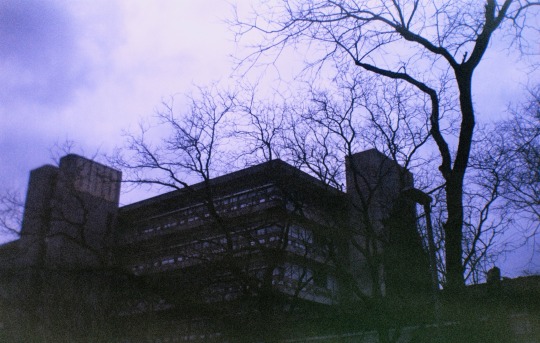

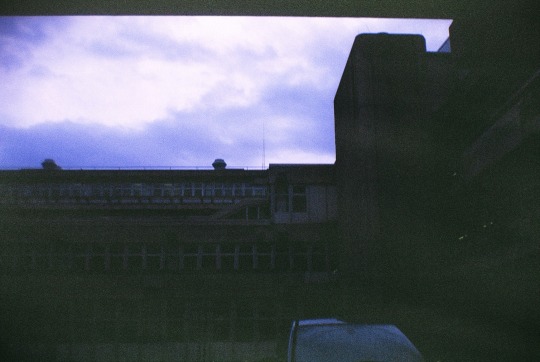
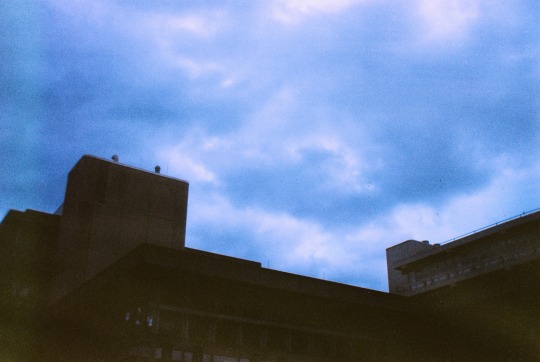
Another little experiment with my Agfa Box, but because of the film being expired for almost 30Years now, the results were underexposed and yellow.
In the end I digitally edited them to death and that‘s the result 😂😂
It was a ISO 100 medium format film by Kodak from somewhen about 1990 cause it expired in 1994.
#film photography#analogue photography#vintage aesthetic#retro aesthetic#retrowave#vintage asthetic#vintage goth#goth aesthetic#gothic#brutalism#brutalist#brutalistic architecture#70s aesthetic#70s architecture#theoretical physics#expired film#medium format film#medium format#medium#120 film#agfa box#agfaphoto#kodak film#kodak#dark aesthetic#edit#color negative film#filmisnotdead#architecture aesthetic#architecture
183 notes
·
View notes
Text

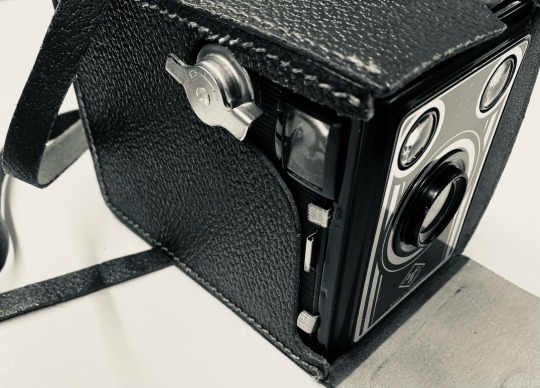
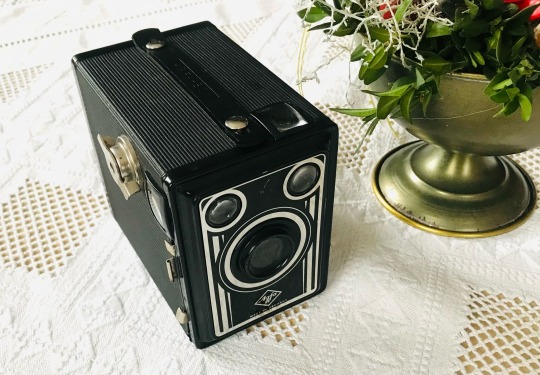




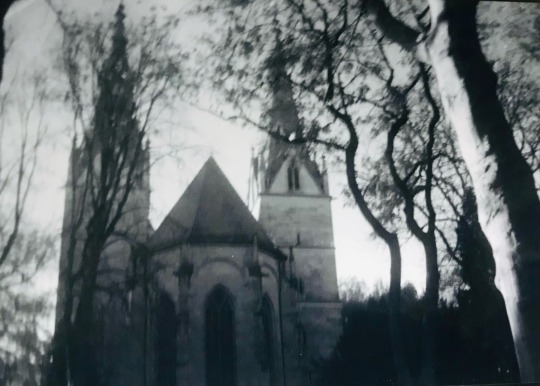
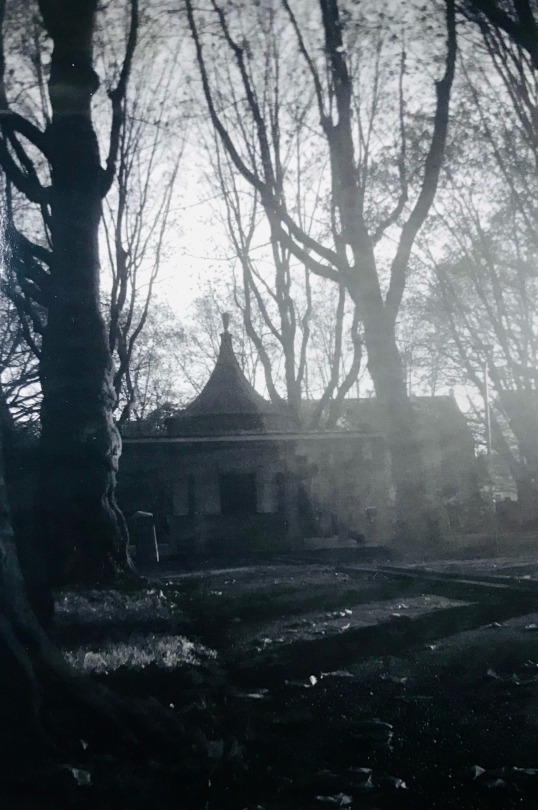
Those are some pics of my „Agfa Box“ from the 50‘s. The principle of the Box Camara is the most easy one, there‘s basically just one lens and a medium format film (I think it was invented by Kodak in the early 20th century). Today it‘s possibly the most unconventional way to take pictures, but even though the results aren’t perfect, i just love it 😅.
I added some of them to give you an example, but I will load up some more of them on my separate film photography blog ( fabio-271205 ) later this week!
#50s#film camera#medium format#agfa#agfaphoto#agfa box#box camera#film photography#camera#1950s#vintage aesthetic#black and white#vintage photography#old school cool#medium format film#gothic
48 notes
·
View notes
Text
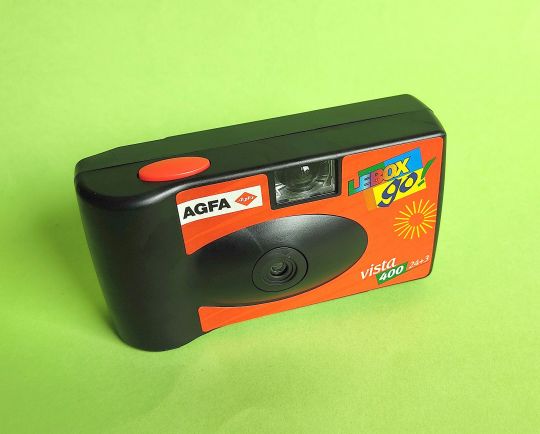
Agfa LeBox go! Holiday (1998)
Single use camera with Vista 400 film
No flash - 27 exp. 35mm color
0 notes
Text






















A photographic workflow
Since I really love reading about other people's workflow, here is mine. I decided to test my Agfa Selectronic Sensor S. Therefore, I put in 24 exposures of Fomapan 200 that I bought on a roll and fed into a spooler. I also bought the film magazines. This saves money. I photograph essentially in black and white for three reasons: the first is that an element of complexity is removed from the equation, namely color. The second is economic: color film costs an inordinate amount of money. For color, I prefer to use my Canon Powershot G10. Finally because with black and white it is easier to be in control of the process from start to finish. Loading the camera, I took a ride to the northern outskirts of the city, Trento, where all the administration buildings are located. It was a cold and overcast day, the weather forecast had announced snow. Back home I pulled out the film tail using another piece of slightly wet film. At that point I inserted the magazine into my Lab-Box, which allows development in bright light, hooked the film tail, closed the lid, and loaded the film into the spiral. At this point I prepared the developing liquid, 300 ml of caffenol, which I now use all the time and with consistent results, for developing black and white negatives. I used this recipe: https://filmdev.org/recipe/show/11645https://filmdev.org/recipe/show/11645 When development was finished, I hung the film to dry. Once dry I digitized it using a Sony a7 digital camera with a 50mm macro lens from Pentax, mounted with an adapter. The camera is mounted on a moving column, while the negative is held thanks to a Lomography gadget that also produces the necessary backlighting. The camera is connected with a USB cable to the PC, which-thanks to a remote control-allows shooting from a distance, without touching the device. After capture, the negatives are processed in Darktable (open source). Images are retouched to fine-tune brightness and contrast, although in general only a few steps are required.
#mine#trento#italy#photographers on tumblr#streetphotography#filmsnotdead#photography#film photography#black and white
8 notes
·
View notes
Text
Hiya, folks!

I'm Ian (any pronouns) and I collect and (attempt to) restore antique cameras! I own about seven cameras in total but these are the cool ones:
(from left to right)
1931 Agfa Ansco Box-Spezial
1955* Kalimar A
1926 Agfa Ansco PD16 Clipper (my current favorite)
1974 Canon Tlb
1964 Imperial Mark 27
The Canon and the PD16 Clipper both work! though I haven't gotten the film I shot with them developed yet, so I don't know how well they turned out yet...
I haven't tested the Kalimar or the Box-Spezial yet, but I'm pretty sure they both work, too. The Box's shutter is a little sticky, but otherwise, they're both in great condition. Now, I have no idea if the Mark 27 is operational, because it takes 127 film, which is a pain in the ass to find. I can use 120 in all the others.
As I said, I haven't developed any film that I've shot with these cameras yet, but I'm taking a photography and film development class this fall, so I figured I'd bring y'all along for the ride! Hope you like photography and old cameras as much as I do! :)
*I think the Kalimar is 1955, but I honestly don't know for sure. It's near impossible to find info on Kalimar online. :/
3 notes
·
View notes
Text
More old tech
Well, I'm not sure if this could even be called old tech because it's so old it's from my great grandfather's time
My grandparents heard I love old tech so much so they got me this Agfa Synchro Box from 1949-1957, it is as old as the grandparents themselves

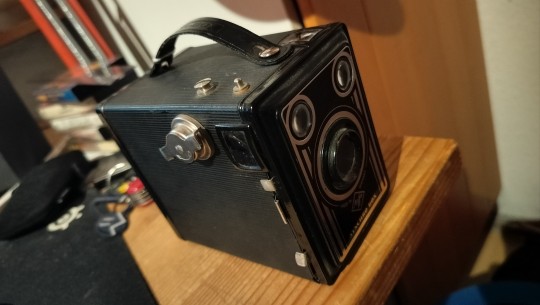
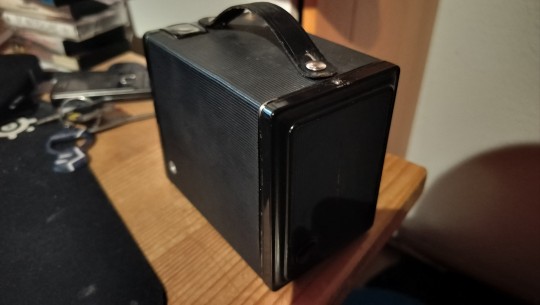
According to my brother, the film it uses is so ancient and obsolete we'd need to develop the photos ourselves if we'd ever want to use it
Yeah this is literally just for display, since it does look nice.
4 notes
·
View notes
Text
Attention everyone in the replies and the tags that are grieving the 'death' of special features. They still exist. Don't get me wrong, they're not as mainstream as they were in the DVD boom (like Disney wants out of physical media entirely, trying that with my home of Australia, please sign petitions and complain through the Disney Australia site by the way).
They are a niche now (so you probably won't find the latest box office hit amongst these), and us collectors of boutique blu rays have been doing okay. Boutique blu rays have way more special features packed in than even DVDs from the 2000s. Yeah, some brands are expensive (Criterion is pretty much the top of the bunch for a reason), but some aren't and ebay is a godsend for trying to find cheap secondhead ones. I know facebook is the devil, but facebook groups of such collectors has been helpful in finding cheap copies.
Sites like Deep Discount, WOWHD, and Oldies also help, and whatever most local middle man boutique home media website bops about in your country. And check out local fairs. Probably won't have the boutique stuff, but they often have DVDs from the DVD boom.
And I will admit, first tip, get a blu ray player that can change what region code it can play. Region code is the bane of any collector. Or if you can't afford one, get an external blu ray player for your laptop, VLC can bypass the region lock.
Anyway, the point of my reblog was to list boutique blu ray and DVD labels that are worth checking out if you want to have physical media in your life instead of assuming streaming killed it outright.
If anything, I learnt that you'll find more of the movies you want on physical media than on streaming (like I got into collecting before everyone else noticed streaming's slow decline because Danger Diabolik kept disappearing on streaming platforms).
I also want to recommend them since quite a number of them are also restoration efforts and archives that could use more support. Some I bought from before, some I haven't but heard good things.
Arrow Video/Films: Mainly horror cult films, but also a mix of classics. Very prolific. Packed with special features. Often cheap on eBay, unless it's the rare out of print ones *eyes Killer Klowns from Outer Space*. And due to some brands like Arrow wanting to get into 4K UHD, some collectors are selling their regular blu-ray copies, which is great for those of us who find 4K too uncanny valley (like it's really great time to get an Arrow edition of Blood and Black Lace blu ray that used to be so expensive to get).
American Genre Film Archive: Essentially Something Weird's successor. A non-profit all about hunting, conserving, restoring, and distributing exploitation films that wouldn't normally get this treatment. Some of you may raise an eyebrow at that, but think about how many old school indie shorts and films would've been forgotten in low quality limbo if not for these loving efforts. Queer films, for instance. Like, the AGFA is where I got my blu ray of the Gay Girls Riding Club's series of 1960s drag shorts.
88 Films: I haven't gotten anything from them yet, but I heard this is a great goody bag of Hong Kong cult action films. Along with other varied niche films and a lot of special features. Ever wanted a commentary of Street Fighter? They have that.
BFI: Pretty much Britiain's Criterion. Sometimes even having films that are also in the Criterion Collection, so pretty good option when it comes to cost. They're a charity all about preserving film and TV in the UK. They have a massive archive of not only British films but also international films, and sell blu rays of them with lots of special features *eyes that rare out of print BFI copy of Funeral Parade of Roses*.
Criterion Collection: I mean...no introduction needed. They invented the movie commentary. They've been THE top tier DVD distributor. They defined what a boutique blu ray is. So I'll just give a tip. Because they've been at it for so long, like as far back as laserdiscs, some of their editions...are a bit out of date. What I mean is if you have a specific film in mind that Criterion has, it's best to check what other companies did with their edition of the film most recently. Like, I got Eureka's 2014 edition of Youth of the Beast instead of Criterion's 2005 edition of the film because it had more special features. That would also help cut down cost.
Discotek: Basically the best go-to for those into anime that isn't recent, including shows and movies deemed license rescued. Like, a lot of Lupin III specials on here for one. Often found on RightStufAnime. It's affordable depending on where you live. Like, out of reach concerning shipping for us Australians (*eyes the blu ray of Mystery of Mamo*), but you Americans will have a great time. And I heard they're great when it comes to subtitles.
Eureka: This is the most classics company to ever classic'ed. Although there some vibe outliers. Like, they're releasing a special feature packed edition of Valley Girl.
Imprint/Via Vision: My first. It's where I got my boutique blu ray copy of Danger Diabolik (not to say I never had blu rays or DVDs before then, just that this was the first I got with this awareness of boutique blu rays). And they're Australian, lots of copies are found in JB Hi Fi. So, yay, affordable boutique blu rays of old school movies and TV shows without shipping BS for us.
Indicator/Powerhouse: Stunning blu ray collection of underrated vintage gems, cult films, and kitsch films. They got film noir. They got Ray Harryhausen. They got William Castle. They got the best edition of Sweet Charity. All packed with as many special features as Arrow, sometimes maybe even more. And honestly, this is the one boutique blu ray company I would recommend getting directly rather than through a middle man. The blu rays that aren't boxsets are pretty affordable. And they provide region free copies.
Kino Lorber: Hit or miss when it comes to inclusion of special features, but they are expansive in what films and such they have, from all over the world. Films that were once forgotten because they weren't box office hits or artistic classics? Yep (What A Way To Go, Modesty Blaise, there was Dr Goldfoot and the Bikini Machine which was out of print...I managed to get that white whale). Lesser known silent films? Yep. Documentaries? Yep. 1950s PSAs? Apparently yes. There's just so much. And because of that, there's overlap of subjects I think will interest you. Like it's where you will find queer silent films, or queer documentaries like The Queen.
Network: They've recently shut down, being liquidated at the moment. But hopefully you'll find copies on eBay and such. Blu Rays of British movies and shows. Was the go-to for British sitcoms and Gerry Anderson shows.
Olive Films: I just learnt today they aren't selling anymore, but you might still find them through the middle men. They would just be rarer now. Overlooked vintage cult films around the world. Bit hit or miss when it comes to inclusion of special features. Eg: a lot in A Bucket of Blood, barely any on The Great Spy Chase or The Brain (1960s French one, not '80s horror one). I mean, the original French DVDs of the latter do have special features, but those special features don't have subtitles so I went with Olive Films' editions since I do like the films anyway.
Second Run: High quality and artistically fascinating world cinema, you can find them with decent prices on BFI's shop. I don't know how many people would've heard of the films they distribute, believe me, I'm in the same boat. But I think this is a good opportunity to check out films that intrigue you, but you never heard of. Like, seeing these has gotten me intrigued about checking out Karel Zeman's work.
Severin Films: Into video nasties or films similar to video nasties? That's what they do with high quality and special features that you rarely got to see back when these were on VHS. They also do relevant documentaries and a few outliers that are still cult films.
Shout Factory/Scream Factory: Shout Factory distributes a lot of cult TV shows (including cartoons, lot of Nickeloden shows) on blu ray and DVD, MST3K fans like me are very familiar with it. Scream Factory is pretty much to America what Arrow is to Britain, providing special feature packed blu rays of horror cult films.
Vinegar Syndrome: The most cultiest of cult films, to the point where they include vintage porn. They restore them as well as distribute them, so this will be the clearest you'll ever see Hobgoblins, Killer Condom, and Sex World.
A honourable mention is collectively the 'studio vaults' of the original big studios. They do still have blu rays, usually with special features, especially commentaries, of their vintage and classic films. Under labels like thd Warner Archive Collection.
And since a lot of labels have distributed the same film from time to time, I recommend checking DVDCompare to see which edition has more special features or more of what you specifically want.
I welcome any other collectors out their to recommend labels they know, it's more than likely I missed some due to inexperience.
You know the biggest loss of the decline of physical media and the rise of streaming? DVD special features.
#home media#blu rays#boutique blu rays#dvds#infodump of home media labels that still have special features#sorry but people going on about 'the death of special features' just reminds me of monty python's 'I'm not dead' bit
85K notes
·
View notes
Text
KAPSA Box Camera
On my blog, February is a special time for vintage camera enthusiasts like us-it's Box Camera Month, a time to celebrate and explore the unique charm of these classic cameras.
Looking through my collection, I noticed I had several different box or box-style cameras that I wanted to use and write about. So, in the middle of January, I thought I should spend the month of February using and writing about the four box cameras I was thinking about.
The first camera that I noticed was the Kapsa camera. It's been on my shelf for a couple of years, and I purchased it in a large group of cameras from an online auction. At first, I didn't think too much of the camera as the items within the group I was primarily interested in were a couple of Olympus Pen F half-frame cameras. As I was unboxing and unwrapping the items I had purchased, the Kapsa was a camera that drew my attention due to the heavy Bakelite material. The name was one that I wasn't aware of.
After doing some research on the camera after the unwrapping, I found out that the camera is rare in North America because it was made and sold in Brazil. I thought that was unusual and dug a bit more into the camera; it also comes in an aqua-blue color, which makes me want to get that version even more because of my love for colored and unusual cameras. I found even more interesting information when I did more digging into the camera and the company that manufactured the camera.
The Company.
D. F. Vasconcellos (DFV) manufactured the Kapsa camera in the 1950s, but the company, which was founded in 1941 in Sao Paulo, Brazil, began manufacturing precision optical instruments, like surgical microscopes and other items for the Brazilian military.
In the 1950s, D. F. Vasconcellos diversified into consumer items like binoculars, magnifying glasses, and loupes. This was also the time they ventured into camera manufacturing, a move that filled a growing market for photography in Brazil.
My guess is that companies like Kodak and Agfa, which were making simple cameras and importing them into Brazil, were somewhat expensive for the average Brazilian consumer. Since D. F. Vasconcellos was getting into the consumer market, they decided to manufacture an inexpensive, well-made, but simple camera for the Brazilian market.
Getting into the camera manufacturing business must have been successful because they made cameras other than the Kapsa for the Brazilian market. They had a total of six cameras in their lineup. Some of the different cameras D. F. Vasconcellos made are very similar to some of the cameras made by Ansco. One camera made by D. F. Vasconcellos was the Zina 25, which is a copy of the Ansco Cadet II. There are thoughts that some of the cameras made by D. F. Vasconcellos were from older Ansco molds. This makes sense, as other cameras within their lineup have similarities to the Ansco line.
D. F. Vasconcellos continued to manufacture cameras into the mid-1960s. Still, soon after, they shut down their camera manufacturing to concentrate on the items they are known for today. According to their website, D. F. Vasconcellos manufactures surgical microscopes and other specialized equipment used in the Ophthalmology, Veterinary, Otorhinolaryngology, and Dental fields.
My Camera:
My Kapsa camera is the size of many standard box-style cameras from the 1950s. It's 4.5" tall, including the strap lug, 3.75" wide, including the winding knob, 4.75" deep, and weighs 1lb. 2.6 oz and is made of a thicker Bakelite material with a pebble finish over the camera body. The Kapsa camera has a 110mm F11 Vascromat lens. Similar to many other box-style cameras, there are two viewfinders on the camera. The viewfinder on the top of the camera is for vertical format photos, and the second one on the side of the camera is for horizontal format photos.
There are a couple of interesting items within this camera. The first is the controls on the right side of the camera as you hold it, which adds a bit of complexity to the camera. On top is the shutter settings for "I," which stands for instant and has a shutter speed of around 1/100 sec. The other setting is "T" for times exposure. Next to the shutter release is "Trava" or Lock, so the shutter doesn't accidentally trigger while transporting the camera. Under that is the ability to set three different apertures, F11, F16, or F22, and along the bottom is the focus control, which is in meters. There are also flash contacts on the camera for their bulb flash gun, which you can see in the posted ads, but something I don't have.
To open the camera, the locking/unlocking lever is on the left side. This lever allows you to open the camera to load/unload the film. You turn the dial to "ABRE" to open the camera or "FECHA" to lock the camera. Once the camera is unlocked, the right side of the camera pulls away from the camera body so you can load or unload the film.
There are two "wings" on the camera that convert the camera from a 6x9 format camera to a 6x4.5 format camera. I liked this feature as it allows the photographer to get twice as many photos from their roll of film. If you're in the 6x9 format with the "wings" retracted, you'll get eight pictures on the roll, but by flipping the "wings" over the film opening, you'll get 16. The one thing that you'll need to remember, and this alludes to me at times when I do this, is it also changes the format of the image. If you're in the 6x9 format, the camera is in the vertical format when holding the camera vertically. Once you change to the 6x45 format, the format of the image is horizontal even though you're holding the camera vertically. It's just something you need to be conscious of when changing formats.
Many of the articles I read about the Kapsa camera state that it can use either 120 or 620 film. However, my camera is only set up for 120-size film, as the film reel holders have larger openings for 120-size film, not the smaller openings for 620-size film reels.
My Kapsa camera has a couple of issues. On the back of the camera, there should be two red windows for the two formats the camera can use. The first issue is one of the red windows on the back of the camera, which reads the frame number when advancing the film, is missing. It's the right window that's missing, and it is used for the 6x4.5 format photos. That's not a deal breaker when it comes to using the camera. I just taped a small piece of foil over the window since I didn't have red acrylic to glue into the camera. Also, there is a small ship in the Bakelite close to the seam where the film insert fits into the camera body, so I added a small piece of black tape when shooting. My camera is also missing the strap.
My Results:
Since my camera shoots 120 film, I loaded a roll of Ilford FP4 Plus, 125 ISO film into the camera with the "wings" back so I was shooting 6x9 format images. The plastic winding knob is on the right side of the camera, just behind the horizontal viewfinder. I wound the film in the first frame, walked through the neighborhood, and snapped a few images.
Once I was done, I got out the dark bag and processing equipment, loaded the reel with the film, and processed it. Here are some of the results.
Conclusion:
Shooting a box camera brought back some great memories from childhood. I still enjoy holding the camera in a lower position and looking through the waist-level finder to frame the image. Maybe that's why I enjoy medium-format cameras so much; it's the tactile feel of using this mechanical instrument to capture memories that I'm fascinated with.
The camera was fun to use, and the images are good, especially considering what many people feel is a toy. But the world took millions of images with this style of camera.
Thank you for taking a few minutes from your busy day to read about this fun and somewhat rare camera from Brazil. Now, I will be on the hunt for the blue model, preferably in better condition than the camera I have.
Until next week, please be safe.
#Camera#camera collecting#Camera for fun#film shooter#film photography#Film#film#fun with film#film camera#film camera collector#film camera collectors#film in camera#120 camera#120 film#120 film camera#Brazil#Cameras from Brazil#brazillian camera#box camera#6x9 format#6x9 format camera#645 format#645 format camera#D. F. Vasconcellos#Sao Paulo#Sao Paulo Brazil#Bakelite#Bakelite Camera#fun camera#Fun Camera
0 notes
Text
Contributor's Spotlight: What's inside Pandora's talk box by @pandoras_talk_box
“What IS inside Pandora’s Talk Box? I should know…I’m Lindsay Denniberg (AKAPandora), owner of Pandora’s Talk Box Productions , and director of the cult horrorfilm Video Diary of a Lost Girl If you haven’t seen it yet, that’s OK! It’s now available on Blu-ray through AGFA and Vinegar Syndrome! Video Diary of a Lost Girl is a rock and horror fantasy where we meet the immortalLouise and her…
1 note
·
View note
Text




Some more Agfa-Box Pics from Heidelberg 🏰
📷: Agfa Box (ca. 1950)
🎞️: I acutually don‘t remember 😅 (but it was expired like since the 90s)
🗓️: Summer/Fall 2024
🌍: Heidelberg (Germany)
#film photography#analogue photography#vintage aesthetic#retro aesthetic#retrowave#black and white#agfacolor#agfa box#agfaphoto#agfa#50s#vintage asthetic#vintage vibes#medium format film#medium format#6x9#old school#old castle#castle ruins#heidelberg#german castillo#germany#europe#filmisalive#filmisawesome#filmisnotdead#film is not dead#film is alive#film is forever#film is better
22 notes
·
View notes
Text
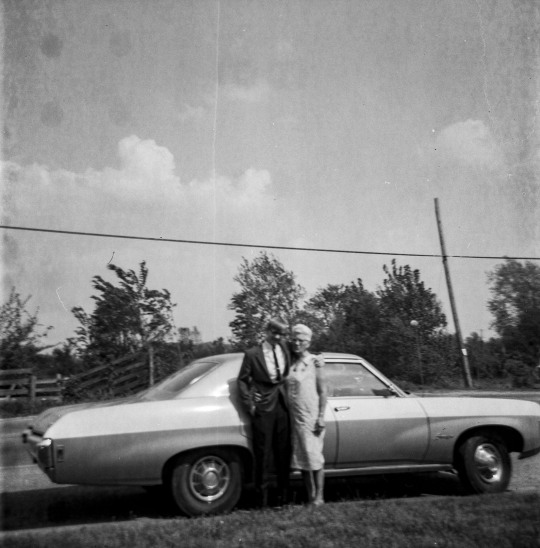
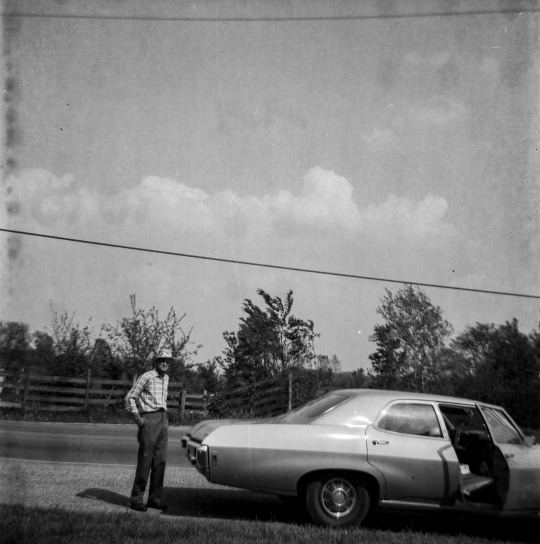
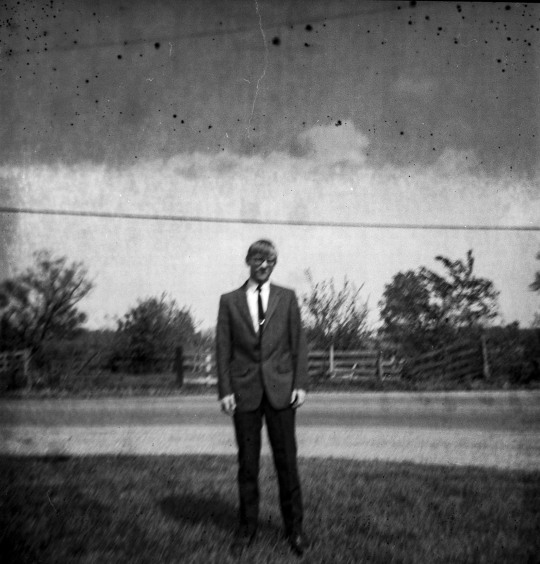
Acomiadant el fill / Saying good-bye to the son; Amb el gran cotxe / With his large car; Un Oscar Dalmau a Ohio? by SBA73
Via Flickr:
Ningú havia vist aquestes fotos fins ara, sobretot els que les varen fer. Fins que jo les he revelat ara. S'anomena "found film" a aquelles fotografies en pel•licula o placa que es troben sense revelar dins càmeres velles o per altres racons. La gracia és que ningú ha vist mai aquestes fotografies. Per l'escena, sembla un matrimoni acomiadant al fill que s'envà... potser a la universitat, a una feina llunyana... qui sap. Algú sap identificar el model de cotxe? Aquest rodet de format 620 prové d'un conjunt comprat a algú de Botkins, Ohio, Estats Units. Es tracta d'un rodet sense marca però amb el text Panchromatic Film i Made in Belgium. Això em fa pensar que es tracta de emulsió Gevaert o Agfa-Gevaert. Pel tipus d'escena i el cotxe, es deu tractar dels Estats Units (Ohio?) cap als anys 70. Al paper exterior algú va anotar que la càmera emprada fou una Kodak Duaflex II, una pseudo-TLR amateur. Aquest rodet el vaig revelar amb HC110 durant 5 minuts a 20º. =================================================== Nobody, even less the author, had seen these pictures until now. Until I've developed them in the dark room. They call "found film" at those images in film or plates that are find undeveloped inside old cameras or in other places, like boxes or old houses. The scene seems to show an older couple saying good-bye to their son who is going to... the college? some distant workplace? Who knows... Any idea of the model of the car? This 620 roll was part of a pack I bought from a seller in Botkins, Ohio. It was only marked as "Panchromatic Film" and "Made in Belgium", wich makes me think it was a Gevaert or Agfa-Gevaert emulsion. These pictures were probably taken in the US (Ohio?) in the 70's. In the outside paper somebody had noted that the camera used was a Kodak Duaflex II, an amateur pseudo-TLR. This roll was developed in HC110 at 20ºC for 5 minutes.
0 notes
Text
Agfa Agfamatic 1008 + Agfacolor CNS 110 film + original box
Agfa Agfamatic 1008 + Agfacolor CNS 110 film + original box 110 camera including 1 film + original box mint NewoldStock never been out of the box

View On WordPress
0 notes
Video
youtube
PRESERVING GENRE FILM HISTORY ONE FRAME AT A TIME! | Against The Grain | Documentary Review
This is my review for the 2023 Vinegar Syndrome documentary "Against The Grain".
Which explores Blu-ray boutique labels and their efforts to recover and restore lost and forgotten genre films.
It's a peek behind the scenes of not just Vinegar Syndrome, but also, people working for other Blu-ray boutique labels like Severin Films, AGFA, Grindhouse Releasing, Kino Lorber and Something Weird.
"Against The grain" is a special feature included in the @vinegarsyndromefilms "Lost Picture Show" 10-Film Box Set.
Trailer: https://www.youtube.com/watch?v=wMx4tEwVcn0&t=1s
Lost Picture Show Box Set: https://vinegarsyndrome.com/products/vinegar-syndromes-lost-picture-show
PLEASE LIKE! SHARE! & SUBSCRIBE!
➤ Merch Store : https://www.etsy.com/shop/GrindhouseFunhouse
• INSTAGRAM: https://www.instagram.com/grindhousefunhouse • FACEBOOK: https://www.facebook.com/grindhousefunhouse • REDDIT: https://www.reddit.com/r/grindhousefunhouse
1 note
·
View note
Text
B&W film stock comparison
Since I do shoot quite a lot of b&w I wanted to give an overview of the stocks I have used so far and my thoughts on them. All of them shot at box speed.
Agfa APX 100/400 (panchromatic)
This was one of my go to film stocks for black and white, because I like the vintage look it creates combined with an old lens, however the grain is quite big in the 400 ISO stock, and the contrast is a bit too low for my taste.
Rating: 7/10

Adox CHS 100 II (orthopanchromatic)
I love Adox stocks for their fine grain and good contrast and this one is no exception.
Rating: 8/10

Rollei Superpan 200 (panchromatic)
Since I am fond of high contrast film stocks, this one is my absolute favorite. It is the perfect fit for me with fine grain and nicely balanced contrast.
Rating: 10/10

Kentmere Pan 100 (panchromatic)
Intense contrast, although it's not as balanced as the Rollei Superpan. The only problem I could see is that the grain is quite prevalent for a 100 ISO stock.
Rating: 9/10
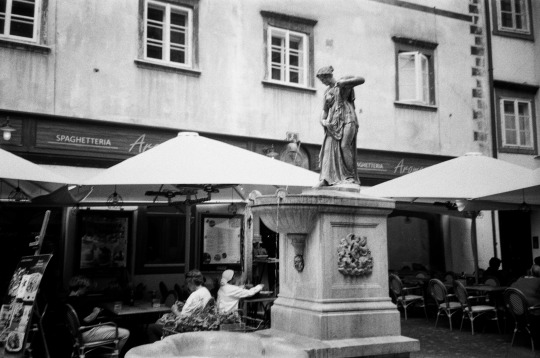
Adox Silvermax 100 (orthopanchromatic)
My favorite b&w film stock, unfortunately now discontinued and really hard to come by. Silvermax has probably the finest grain I've ever seen, and nice contrast.
(unfortunately I don't have a scanned example)
Rating: 10/10
#35mm#film photography#lensblr#life on film#original photographers#photographers on tumblr#analog photography#filmisnotdead#staybrokeshootfilm#analog#film aesthetic
1 note
·
View note
Text
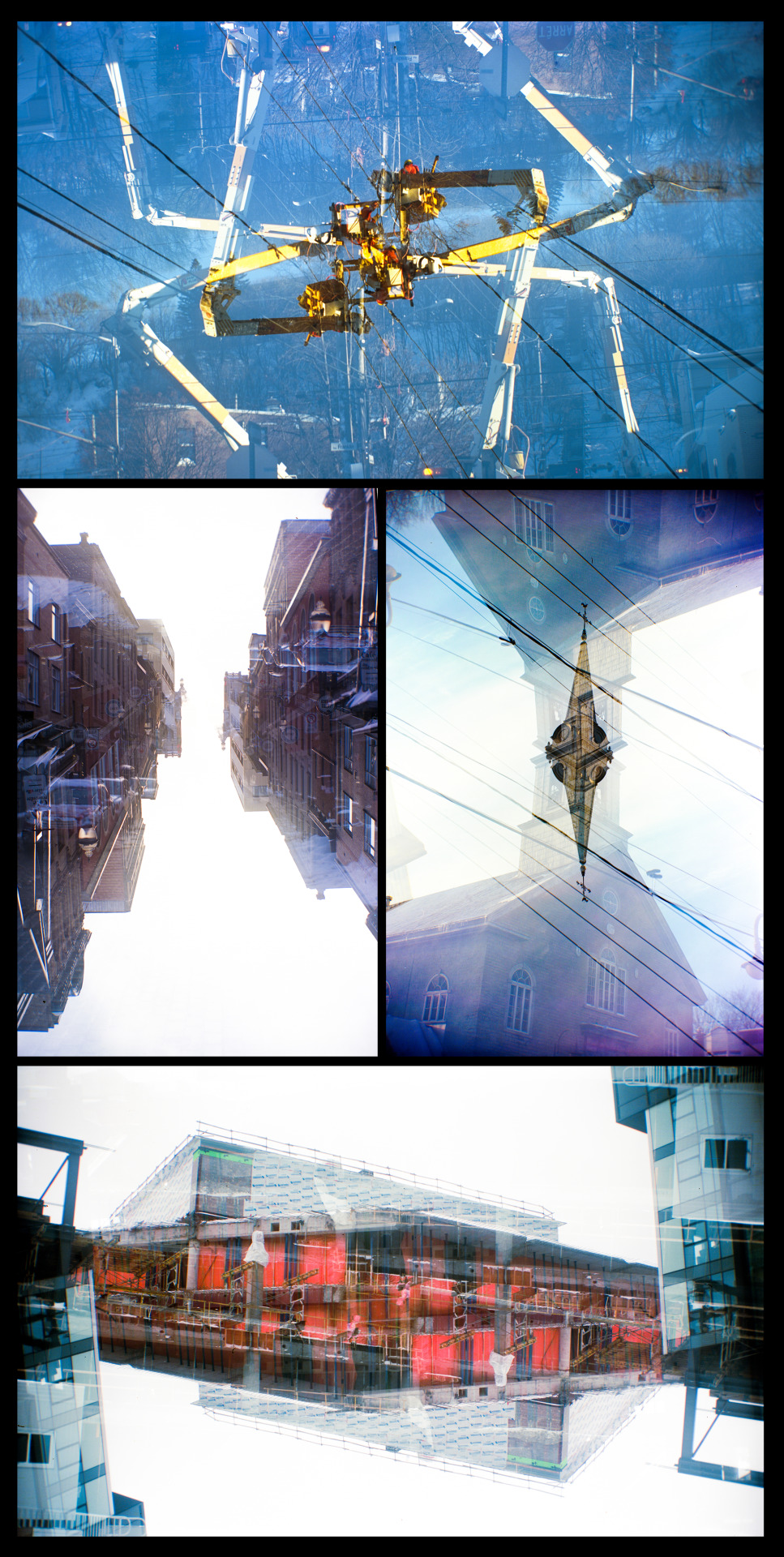
Sculptures entropiques assemblées
#agfa box#6x9#analog photography#film photography#medium format#analog#filmisnotdead#kodak ektar#kodak#photography#urban landscape#double exposure#landscape#color film#original photography on tumblr#original photographers
10 notes
·
View notes
Text
Ansco Memo Camera
The Ansco Memo camera is this week's camera that I'm spotlighting, and it's a camera I've been itching to use for a while now. It's also the second time I've owned this particular camera. The first time was almost 35 years ago when I came across it at a camera show and was struck by its vertical design with the small round viewfinder on top. At first, I thought it may have been a small, odd box camera, but upon further inspection, it was a fairly early 35mm camera.
My camera collection is constantly evolving, and I had sold the Memo camera I owned. However, my fascination with the Ansco Memo camera persisted, leading me to seek out another one a few years back. This time, I was on the lookout for the Boy Scout version of the Memo camera, a rare find that commands a price twice that of the standard version.
I found the current Memo camera online at an excellent price. The purchase was during the lost COVID years. The camera came with a significantly worn leather case, but it didn't have the needed film cassettes to use the camera. The Ansco camera was introduced between 1926-27, and the regular 35mm cassettes we're accustomed to now weren't standardized until 1934. Any camera manufacturer that made 35mm cameras during this time period had their own 35mm cassettes to use in their cameras. There is another Memo camera that's made by Agfa, which has similar cassettes and is somewhat interchangeable with the Ansco version. Still, I'll talk more about that later in the post.
My Memo camera appeared to be in good working condition, with a functional shutter, so I was eager to use it for this post. I reached out to my friends in the camera-collecting community, and one of them, who had acquired a substantial collection in the past, came to my rescue. He not only had the empty cassettes I needed but also a roll of Agfa pre-loaded film in a cassette that would fit my Ansco camera. His generosity was overwhelming, and I was now fully equipped to use my camera.
The Company:
The Ansco Camera Company has a fascinating history and is a key player in the evolution of photography. Its roots can be traced back to 1842 when Edward Anthony, a prominent photographic supplier in New York, established E. Anthony & Co. Initially, the company focused on importing and selling daguerreotype supplies, but as the industry progressed, it began producing its own photographic equipment.
In 1854, Edward's brother, Henry T. Anthony, joined the business, leading to its rebranding as E. & H.T. Anthony & Co. The company thrived during the American Civil War by supplying cameras, chemicals, and photographic plates, which were critical for documenting the conflict. By the late 19th century, Anthony & Co. was one of the largest photographic supply houses in the United States.
The pivotal moment in the company's history came in 1902 when it merged with the Scovill & Adams Company, a long-time competitor. This merger resulted in the formation of the Anthony & Scovill Company, which adopted the name "Ansco" for branding purposes. Ansco emerged as a significant player in the early 20th century, producing cameras, film, and related accessories.
Ansco's fortunes were closely tied to innovation and competition. It introduced popular products like the Ansco Memo in 1927, one of the earliest subminiature cameras, and the Anscoflex in the 1950s, a unique twin-lens reflex camera designed by the famous industrial designer Raymond Loewy. Its cameras were known for reliability and affordability, appealing to amateur photographers.
During World War II, Ansco faced a significant challenge due to its ties to the German company Agfa. Ansco was owned by the German chemical conglomerate IG Farben, leading to its seizure by the U.S. government under the Trading with the Enemy Act. Post-war, the company was Americanized, and its assets were sold to General Aniline & Film (GAF) Corporation in 1943.
Under GAF, Ansco continued to produce innovative products, including cameras and color film. However, by the 1960s, it struggled to compete with industry giants like Eastman Kodak and Polaroid. GAF eventually shifted its focus to industrial applications of photographic film, and Ansco's consumer products gradually disappeared from the market.
Despite its decline, Ansco's legacy endures in the history of photography as a company that made significant contributions to camera technology and film production. Its influence is still appreciated by collectors and photography enthusiasts who treasure its vintage cameras and historical impact on the field.
My Camera:
My Ansco Camera is 5" tall, including the round viewfinder, by 2 3/8" wide, including the shutter release, by 2 5/8" deep, and weighs 13.8 oz with two empty film cassettes in the camera. The original Ansco Memo camera wasn't leather-covered like mine is or has the shutter release guard. It was a stained wood camera with just a knob ion a lever sticking out of the camera to release the shutter. It wasn't until later in the camera's production that Ansco covered the camera in black leather and then added the shutter release guard to help prevent unnecessary shutter tripping. A wire handle on top of the camera makes it easy to carry the camera when you're not shooting.
The camera has a Wollensak Velostigmat F6.3 lens with an unknown focal length and fixed focus. The camera only has three different shutter speeds, 1/25, 1/50, and 1/100, along with "B." The lens does offer aperture control that goes from f6.3-f16. Both the shutter speed setting on top of the lens and the aperture settings on the bottom of the lens are set by a small slider arm. The shutter release is on the right side of the camera and is protected by a small curved piece of metal intended to help with unexpected double exposures when you're not using the camera. It was more of a nuance than a help. The viewfinder on the top of the camera is easy to look through but doesn't give you an actual rectangular image. It has a more square look, so you must keep that in mind when framing your images.
During this era, 35mm film was mainly used in motion picture cameras. The Ansco Memo uses 35mm, which travels vertically in the camera instead of horizontally, which is more commonplace nowadays. To transport the film across the shutter, the camera utilizes a "claw" method of grabbing the film sprockets on the edge of the 35mm frame and pulling it down across the shutter. The back of the camera, which is removable to lead the film, has a claw mechanism. The film doesn't need to be moved very far as the Ansco Memo isn't a full frame 35mm camera (24mmx36mm). It has a half-frame size of 18mm x 24mm and is in the horizontal format when holding the camera. The film only needs to move about 19-20mm to get to the following exposure.
I was gifted two different cassettes for this camera. I received an original Ansco cassette with a curved side and a fully loaded Agfa cassette, which is the squared-off version. Due to how the camera is made, you can put the Agfa version on top of the Ansco camera. The top is for unexposed film, and the take-up of the cassette with the curved side needs to go on the bottom of the camera. If you look at the camera's take-up area, there are some wooden braces that don't allow the squared-off cassettes into it, but the curved cassettes fit as they should. At this point, I put the unexposed Agfa cassette into the top of the camera and put the film leader into the take-up cassette, and we're ready to go.
To open the film cassettes, one of the sides comes off the cassette. The easiest way to open it is to slightly pince the corner of the cassette; this will release some pressure, and the cap will come right off. Inside the cassette is a coiled wire, which is used to guide the film into the cassette and not have it bunch up. When loading film into the cassette or unloading it into my processing reel, the film would move very smoothly, and there was no problem getting the film in or out, which was a worry when I first started.
To open the camera to load the film, on top of the camera is a slider that you push over, and the back of the camera comes off. Due to the smaller frame size, the Ansco camera takes 50 images on a pre-loaded roll of film. The frame counter on the camera advances up to 50. To advance the film to the next frame, you slide the advance bar on the back of the camera down once, advancing the film to the next frame. Similar to the current 35mm camera, the camera is in the horizontal format, and to take a vertical image, you need to turn the camera. This is awkward, but it wasn't bad when I ran some film through the camera.
My Results:
I put the roll of Agfa Rapid film into the camera and shot about 50 images of walking my dog around the neighborhood. I didn't have a good sense of processing time since the film was close to 90 years out of date. I did a lot of exposure bracketing for each image and exposed the film as if it was around ISO 5 due to the time past prime. After I processed the film, it was completely black, so I figured it was either at some point opened, but there was absolutely nothing on the frames. I looked under a very bright light to see if I could see anything that resembled an image, but absolutely nothing. Not even on the film's perforations.
I have another roll of 35mm film, a roll of Tri-X, which came with another lot of cameras purchased, and on the cassette, it said fresh roll, and knowing that this roll may be bad, I thought I'd load it into the cassettes and give it a whirl. I pulled out the dark bag and loaded this roll of film into the cassettes. This was very easy, and I went through the neighborhood, taking more images. I got home and processed this film roll. I know that Tri-X has been an older film. I did some push processing, and the film turned out OK, but it wasn't a fresh roll of film, and there were other exposures on it.
I didn't want to postpone this post any further, so some of the images have double exposure. I picked the images that either had one or very little, so upfront, my humble apologies for the images from this camera, but overall, these aren't that bad.
Conclusion:
This camera did a fantastic job for a camera approaching 100 years old, and you need to remember it's a half-frame camera.
Besides the bad film on the first roll taken and the double exposures on the second, the camera was fun to shoot. The film cassettes were easy to load with some current film. Now, I'll need to get a fresh roll and try it for the third time. Just knowing the shutter is working and the camera takes images is 90% of the battle. Now I can take my time and update the post with cleaner images once I get some film for the holidays, shoot images, and repost them here.
Thank you for taking a few minutes from your day to look over this post. I can't tell you how much it means to me. Please feel free to email me if you have questions or concerns.
Until next week, please be safe.
#35mm camera#35mm film#35mm film camera#35mm#ANSCO#Ansco#AnscoAgfa#Agfa#Agfa film#GAF#GAF Film#half frame camera#fun camera#Fun Camera#fun with film#cameras for fun#old camera#antique camera#vintage camera#vintage film camera#American camera#camera#camera collecting#cameras you should own#Camera Collecting#camera collecting blog#Camera
0 notes